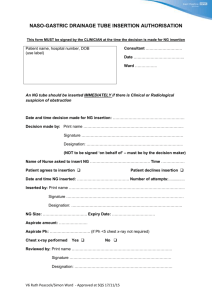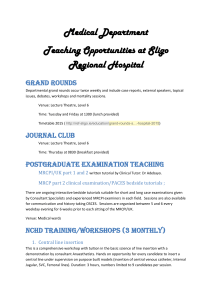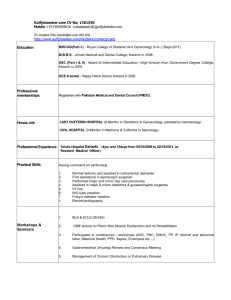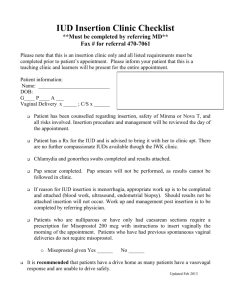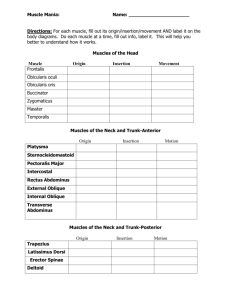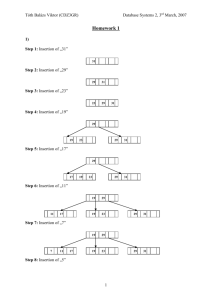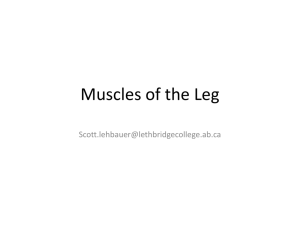Cat Dissection - River Dell Regional School District
advertisement
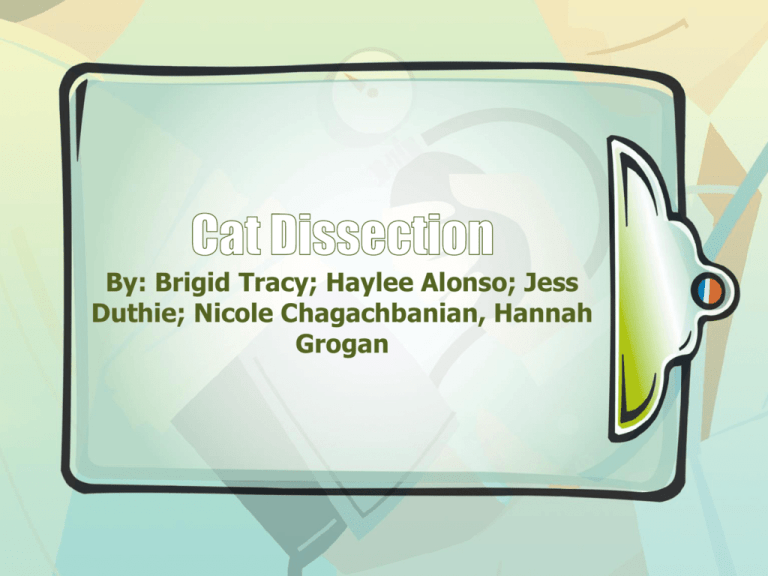
By: Brigid Tracy; Haylee Alonso; Jess Duthie; Nicole Chagachbanian, Hannah Grogan Skinning Pectoralis Major • • • Origin: cranial half of sternum Insertion: proximal third of the humerus Action: adduction of the forelimb Pectoralis Minor • • • Origin: six vertebrae or xiphoid process Insertion: ventral border of the humerus Action: adduction of the forelimb External Oblique • • • Origin: lumbodorsal fascia of the caudal ribs Insertion: sternum and along linea alba Action: compression of the abdomen Internal Oblique • • • Origin: lumbodorsal fascia of the caudal ribs Insertion: sternum and along the linea alba Action: compression of the abdomen Transverse abdominis • • • Origin: aponeurosis of the caudal costal cartilages, lumbar vertebrae, and ventral border of ilium Insertion: along linea alba Action: compresses the abdomen Rectus Abdominis • • • Origin: iliac crest Insertion: cartilage of the S’h-7’h ribs and the xiphoid Action: compresses the abdomen and flexes the trunk Trapezius • • • Origin: 7th thoracic vertebrae and thoracic vertebrae Insertion: acromion process, scapula, and clavicle Action: extends humerus, adducts scapula Latissimus Dorsi • • • Origin: 4th or 5th thoracic vertebrae to the 6th lumbar vertebrae Insertion: Medial surface of the humerus Action: pulls forelimb dorsocaudally Sternomastoid • • • Origin: cranial border of the manubrium Insertion: lamboidal ridge and mastoid process of the temporal bone Action: contraction by both will flex head; individual contraction will rotate head Cleidomastoid • • • Origin: mastoid process of temporal bone Insertion: lamboidal ridge and mastoid process of the temporal bone Action: contraction by both will flex head; individual contraction will rotate head Biceps Brachii • • • Origin: scapula Insertion: radius Action: flexion of the forearm, but also supinates the Manus and stabilizes the shoulder joint Triceps Brachii • • • Origin: lateral head of the humerus; long head (scapula); medial head (medial side of humerus) Insertion: Olecranon process of ulna Action: extension of antebrachium Sartorius • • • Origin: iliac crest Insertion: fascia surrounding the knee and tibia Action: adduction and rotation of the femur and extensions of the shank Gracilis • • • Origin: Ischium and pubis Insertion: thin Apo neurosis associated with the shank Action: adducts and retracts the thigh Biceps Femoris • • • Origin: one head in the cat; ischium Insertion: tibia and patella Action: abducts the thigh and flexes the shank Semitendinosis • • • Origin: ischium Insertion: medial surface of the tibia Action: flexes lower leg Vastus Medialis • • Origin: shaft of the femur Insertion: tibia Rectus Femoris • • Origin: ilium near acetabulum Insertion: tibia Vastus Lateralis • • Origin: greater trochanter and shaft of femur Insertion: tibia Gastrocnemius • • • Origin: lateral head (patella/femur/tibia) medial head (femur) Insertion: Achilles tendon that attaches to calcaneus bone Action: extends the pes and flexes the antebrachium Achilles tendon Gluteus Maximus (smaller) • • • Origin: transverse processes of the last sacral and first caudal verterbrae Insertion: greater trochanter of femur Action: abducts thigh Gluteus Medius (bigger) • • • Origin: iliac crest, last sacral vertebrae, 1’ caudal vertebrae Insertion: greater trochanter of the femur Action: abducts the thigh External Intercostals • • • Origin: cranial rib Insertion: adjacent caudal rib Action: protraction of the irbs, which is required for inspiration Longissimus Dorsi • • • Origin: spines of vertebrae; ilium Insertion: processes of more cranial vertebrae Action: extends the vertebral column Gastrointestinal tract Long winding tube that carries food through its length Esophagus: Liver: Stomach: Small Intestine: Large intestine: Accessory organs Supportive organs that lie outside the GI tract (teeth salivary glands, liver, gallbladder, and pancreas) Diaphragm An internal muscular partition dividing the thoracic and abdominopelvic cavity Lingual frenulum The ventral fold of tissue attaching the tongue to the floor of the mouth Filiform Sharp projections off of the cats tongue to give a friction surface for grooming Esophagus Long, muscular tube that transports swallowed materials from the pharynx to the stomach (behind trachea) Mesentery Double layer of peritoneum that extends from the visceral peritoneum of the small and large intestines to the dorsal abdominal wall Liver Prominent, dark-brown organ lying immediately deep to the diaphragm with most of its bulk on the right side Gallbladder Thin walled sac that receives newly manufactured bile from the liver for temporary storage Stomach J-Shaped enlargement of the GI tract; functions as a temporary reservoir for swallowed food Small Intestine Long winding tube that finalizes chemical digestion and is the only side for nutrient absorption Large Intestine Caudal portion of the GI tract; absorbs water from the contents that arrive from the small intestine, prepares and forms the feces Rectum Terminal segment of the large intestine Pancreas Located just below the greater curvature of the stomach; functions in the secretion of hormones that regulate blood sugar levels, secretion of digestive enzymes and sodium bicarbonate Larynx Box like structure composed of 5 cartilages that create a small chamber; houses the vocal cords which produces sound when exhaled air in channeled through Trachea Tubular air passageway extending from the larynx to the thoracic vertebra, where it divides Lungs Multi-lobed structures located lateral, cranial, and caudal to the heart; consists of many airfilled alveoli Kidneys Bean shaped organs partially embedded in fat against the dorsal body wall Ureters Narrow tubes that transport urine from the kidneys to the urinary bladder at the base of the pelvic cavity Urinary Bladder Reservoir for urine; has the ability to expand Thoracic Cavity (or chest cavity) is the chamber of the human body (and other animal bodies) that is protected by the thoracic wall (thoraciccage and associated skin, muscle, and fascia). Pleural Cavity a closed space (like the inside of a balloon) within which the lung has grown. As the lung grows into the space, it picks up a layer of pleura (outside of balloon) and this is called the visceral pleura. The remainder of the pleura is called the parietal pleura. Pericardial Cavity or pericardial space) is a potential space between the parietal pericardium and visceral layer. It contains a supply of serous fluid. The serous fluid that is found in this space is known as thepericardial fluid. Apex and Base Base: The part of the heart formed mainly by the left atrium and to a lesser extent by the posterior part of the right atrium, directed backward and to the right, and separated from the vertebral column by the esophagus and aorta. Apex: the blunt extremity of the heart formed by the left ventricle Family Picture
